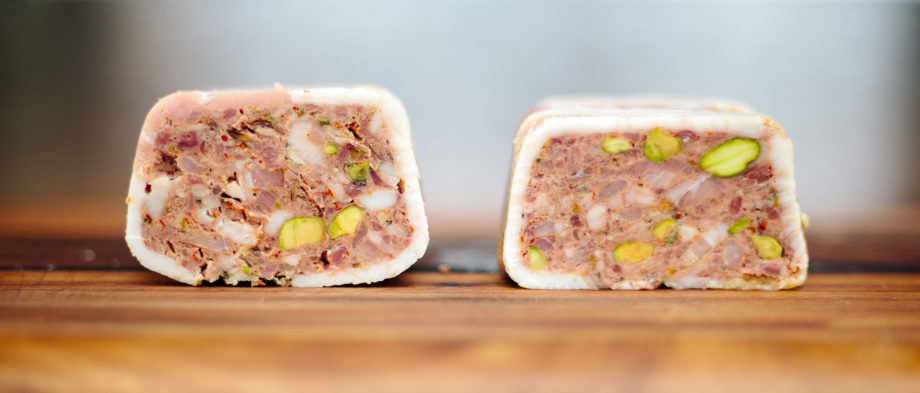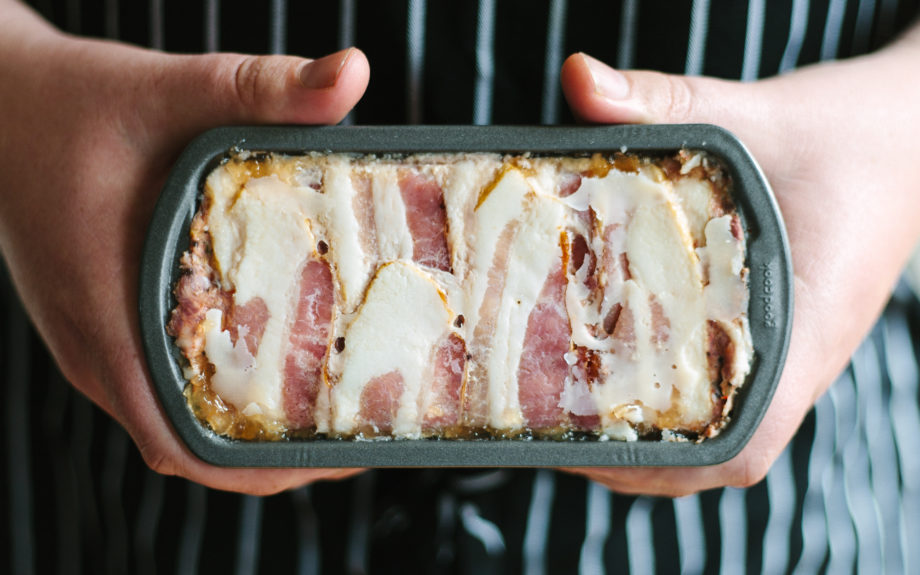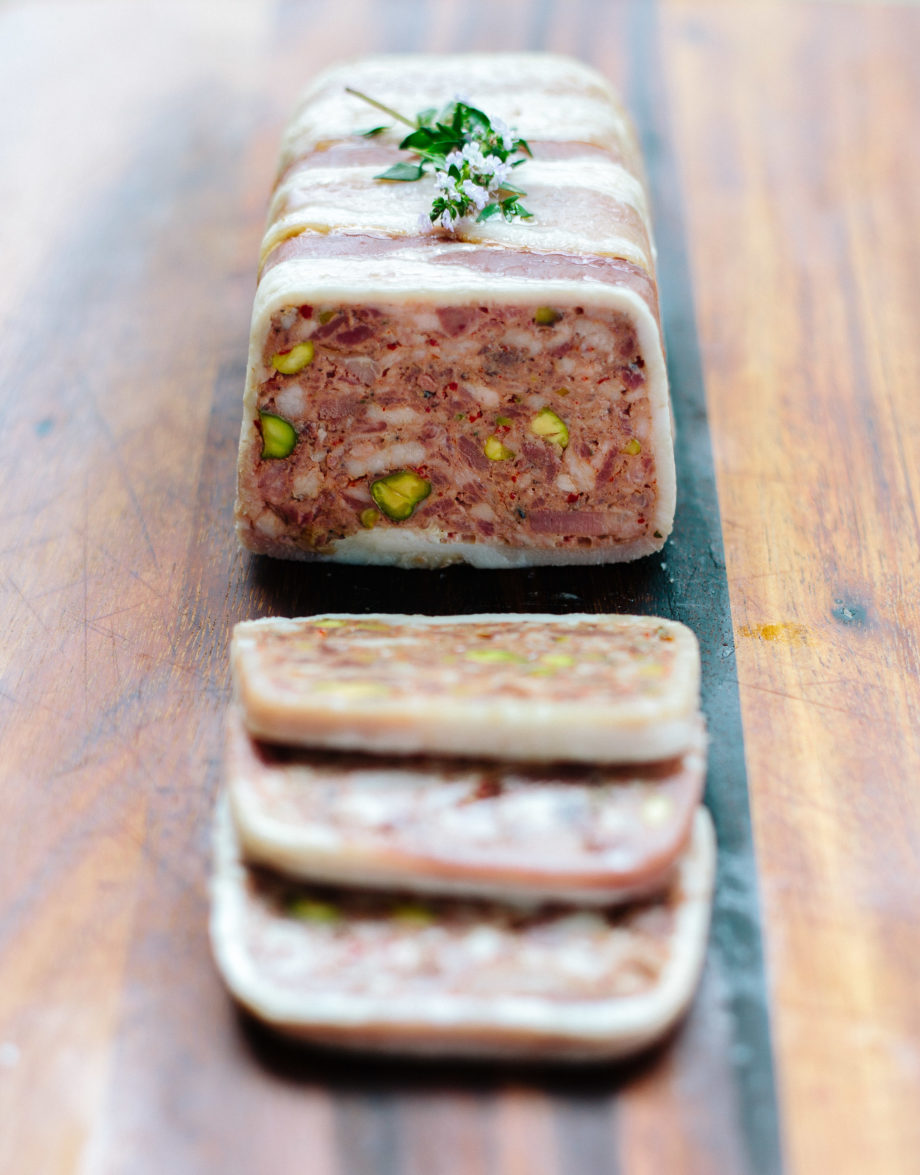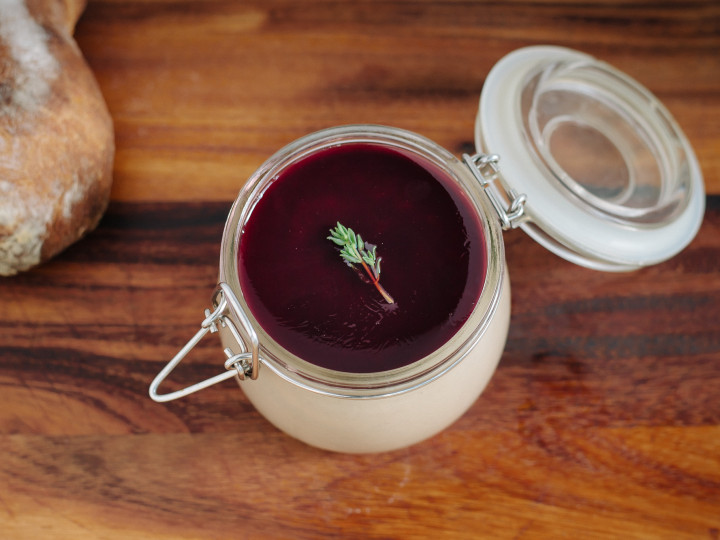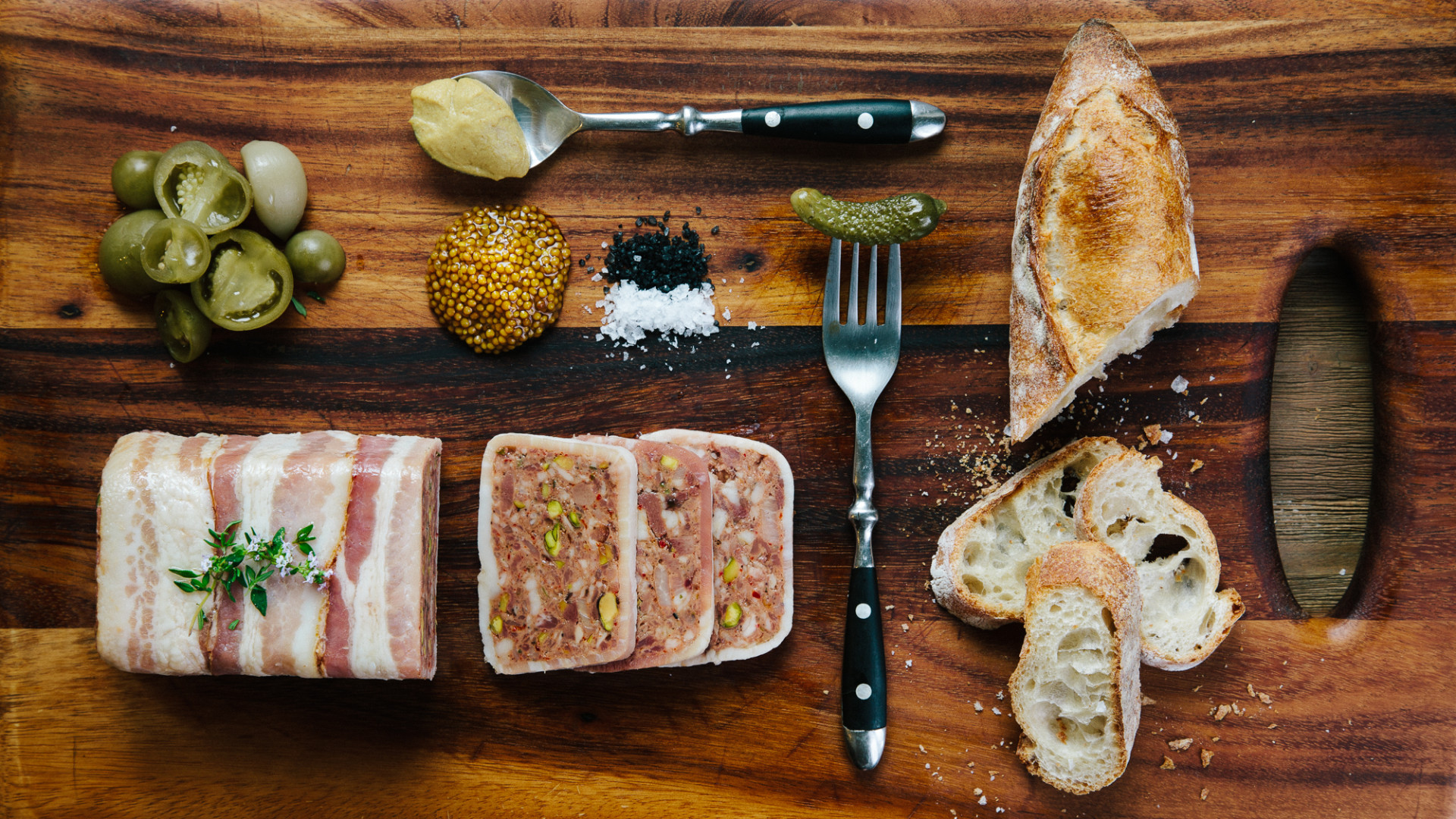
Both rustic and refined, Pâté de Campagne, or country pâté, could be called the cornerstone of charcuterie. Every chef worth their salt has his or hers own take on this French classic. We compare two cooking methods: the traditional bain-marie and modern sous vide.
A Collaboration

Evan Brady
The following represents a collaboration between Our Daily Brine and New York-based chef, Evan Brady. Evan, owner of Craft Butchers’ Pantry, and I met through the Sausage Debauchery group on Facebook (an excellent group, if you’re interested in making salumi). Evan and I share an obvious love for all things charcuterie and salumi, but found our common interests delve much deeper into the scientific approach and understanding of gastronomy. This recipe for pâté de Campagne was developed by Evan.
It’s a Farce
Pâté de Campagne’s humble beginnings can be traced back to medieval Europe, when it was common to cook a farce—or “magic meat mix”, as Julia would say—of chopped meat(s), fat and seasoning inside a pastry crust or fat-lined earthenware. Throughout the centuries French cooks have refined the preparation of pâtés and terrines. The variations of pâté span the gamut of refinement: from rustic, hand-chopped offal to decadent variations incorporating foie gras or truffle garnish.
Farce (def.): A highly seasoned mixture containing chopped meat, forcemeat is an alteration of farcemeat, “stuffing,” and has a synonym—farce. Farce first meant forcemeat stuffing and came to be used metaphorically when a humorous play was “stuffed” in between two more serious acts of the main theatrical presentation.1
In common vernacular a terrine is typically served from the terrine it was molded in, where a pâté is unmolded and served as a sliced loaf. According to the bible of French gastronomy, Larousse Gastonomique, “the word pâté on its own should, strictly speaking, be applied only to a dish consisting of a pastry case (pie shell) filled with meat, fish, vegetables or fruit … a pâté en terrine is a meat, game or fish preparation put into a dish (terrine) lined with bacon, cooked in the oven and always served cold.” They go on to say “The correct French abbreviation of this is terrine, but in common usage the French also call it a pâté.”2 — needless to say, the terms are often used synonymously.
De Campagne Deconstructed
Pâté de Campagne takes many forms. At its core it is a mixture of ground meats; pork and veal are classic, occasionally with ham, or as in this recipe, bacon—and always with liver. Unlike a liver pâté, pâté de Campagne uses liver as a flavoring, not the focus. Meats are typically chopped, or ground with a meat grinder, for the characteristic coarse texture of a country pâté. Spices often include garlic, thyme, cloves, nutmeg, mace, ginger, coriander, cinnamon and white/black pepper, and more. Interior garnish is also common; examples being: nuts, like walnuts or pistachios, dried fruits like cherries, figs or apricots, or the classic and coveted truffle.
A Modern French Method: Sous Vide
The classic French method of preparing pâté en terrine is by bain-marie. A more modern—yet still French—method for preparing pâté is by cooking en sous vide. Sous vide is, arguably, the better method. The concept is the same: slow, gentle cooking, in a water bath. In a traditional bain-marie we often use some fashion of weight, post cooking, to compress the pâté as it cools. One of the benefits of sous vide, literally “under vacuum”, is that a vacuum is used to seal and compress the farce—both as it cooks and as it cools. Additionally, sous vide allows for more precise cooking; we are able to set the water bath to a precise 150ºF/65.5ºC and cook the pâté to equilibrium, never exceeding or overcooking, and allowing for controlled pasteurization.3
Notes on Sous Vide
Vacuum Sealing
Sous vide literally refers to cooking “under vacuum”. Sous vide as a term is commonly used to describe the method of cooking with an immersion circulator to precisely control a water bath, regardless if the food has been vacuum sealed or not (eggs are a good example of this). Cooking pâté en sous vide should always be done with a vacuum-sealed terrine. A chamber sealer is ideal, as you can adjust the pressure to high, remove all of the oxygen and tightly compress the pâté. An edge sealer, like a FoodSaver, also works well. The examples shown here are all done with a FoodSaver.
Immersion Circulator
In the past couple years, lower-cost immersion circulators have come to market. Previously, to cook sous vide required a significant investment in equipment. Thankfully, that’s no longer the case. One of the first lower-cost—yet ample powered—circulators introduced was the Nomiku (pictured upper right). I prefer the Nomiku over the other sub-$300 competitors (several of which I own). It’s by far the smallest, yet powerful enough to keep an uninsulated 5+ gallon/19 Liter water bath within 0.1ºF of target temp. That’s pretty amazing.
Terrine or Loaf Pan
When cooking en bain-marie, the best results are had with a dedicated vessel like a Le Creuset terrine; with sous vide there is no benefit. If cooking sous vide, the type and size of terrine does not matter, as long as it fits in your bath. Here we’ve used small non-stick loaf pans commonly found at most grocery stores. The size is perfect for a charcuterie board.
Cooking Time
Cooking time is wholly dependent upon the size of terrine you use. In order to effectively pasteurize the pâté, it must be cooked until the core registers 150ºF/65.5ºC. After core temperature is reached it must be held at temp for at least 1 minute and 10 seconds, allowing for a 6.5D reduction in Salmonella (3).
One of the benefits of cooking sous vide is that it’s not possible to overcook the pâté. The mini loaf pans took slightly more than 2 hours to reach core temperature. If you are unable to monitor the temp with a probe, then you should cook at least 2.5 hours or more for the same size loaf pan and longer the larger the pan. If using an edge sealer (not a chamber sealer), you can always remove the terrine from the bath, cut open the bag and take a reading. If it has not reached temp, you can reseal and cook for longer. Repeat the process until temp has been reached. If you use a bag with additional length, you can simply reseal the same bag. Note: Food sealed in a chamber sealer should always be chilled before sealing, or it will boil.
Monitoring Core Temperature
The best way to monitor core temperature of any protein cooked sous vide is with a very accurate thermometer called a thermocouple. I use the ThermoWorks TW8060 (I’m now using the ThermaQ) with a PTFE/FEP tip probe to monitor the water bath, and a miniature needle probe to monitor the pâté temp. The ThermaQ thermometer is excellent and allows for a huge array of different type of probes. It’s well worth the relatively small investment.
To monitor temp while under pressure, you will need a needle-thin probe and some sort of high-density foam tape (like the kind used to seal doors and windows). If using an edge sealer, be sure to seal the pâté with the smooth surface of the bag facing up. Use rubbing alcohol to clean the surface where you will apply the tape, let dry. The clean surface will aid in adherence of the tape and prevent contamination when inserting the probe. Clean your probe with alcohol and insert it through the tape. It will retain the vacuum. Handle carefully as you lower into the bath.
For more information on cooking sous vide please see: Sous Vide Cooking 101
The Bain-Marie Method
If you do not have access to the equipment to cook sous vide, excellent results can still be had by cooking in a bain-marie; no doubt, the French, among others, have done so for hundreds of years. Here’s the basic method:
- Preheat the oven to 375ºF/190ºC with convection; or 400ºF/200ºC without.
- Follow the directions (below) until you reach the point of cooking sous vide.
- Tightly wrap the top of the terrine or loaf pan in aluminum foil.
- Prepare your water bath. Use an oven-proof vessel, like a high-sided roasting pan; big enough to hold your terrine and allow for a good amount of water to surround it.
- Place the filled terrine into a high-sided roasting pan and add enough hot water (as hot as your tap will go) to within an inch of the top of the terrine.
- Transfer bain-marie to preheated oven.
- Immediately turn oven down to 250ºF/120ºC, with convection; or 275ºF/135ºC without.
- Begin checking temperature after 30 min. (I monitor temperature in real-time using the wireless iGrill thermometer); when checking temperature, do so by piercing the foil with the thermometer, which prevents the heat from escaping.
- Cook until center/middle of the pâté registers 150ºF/66ºC.
- Remove the pâté from the oven, and allow to cool for 1 hour, remaining covered by foil; the temperature should stay at 150ºF/66ºC for 15+ min., then start to decline.
- Holding at a temperature of 150ºF/65.5ºC for at least 1 minute and 10 seconds allows for a 6.5D reduction in Salmonella 3
- Weight the terrine as it cools (I use a cleaned brick, wrapped in aluminum foil); this will compress the pâté and impart the desired, uniform texture.
- While pâté cools, prepare a shallow ice bath for chilling
- After an hour of cooling at room temperature, place the terrine in the ice bath and chill for an extra hour.
- Remove foil from terrine, wrap tightly in plastic wrap and transfer to refrigerator
- Chill overnight
Service
Serve the pâté de Campagne cold, allowing a day to fully set and develop flavor. Cornichons and a good dijon mustard are typical accoutrements and I almost always serve pickled mustard seeds. When I have them on hand, I love the fat-cutting-acidity of a pickled green tomato.
Oh, and a French baguette. You simply cannot serve a Campagne without a proper baguette.Bon appétit!
Pâté de Campagne Cooked Sous Vide
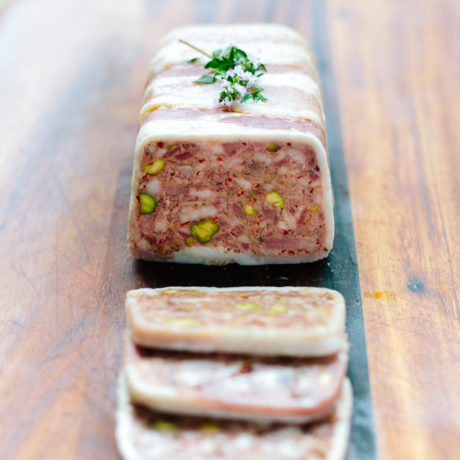
Both rustic and refined, Pâté de Campagne, or country pâté, could be called the cornerstone of charcuterie. Every chef worth their salt has his or hers own take on this French classic. The following details preparation by sous vide method.
Ingredients
- 900g Pork Butt, coarse ground
- 600g to 1,000g Bacon; 300g small dice, plus enough to line loaf pan(s) (approx. 300g+)
- 125g Pork liver
- 125g Chicken liver
- 125g Pork kidney
- 100g Onion, puréed
- 2 Eggs, whole
- 125mL Congac
- 125mL Heavy cream
- 5 Garlic cloves, minced
- 35g Sea Salt
- 15g Piment d’Esplette, or similar red pepper flake
- 3g Cure #1 (optional; retains color and enhances flavor)
- 5g Fresh Thyme Leaves
- 3g Black pepper, ground
- 1g Nutmeg, ground
- 1g Mace, ground
- 1g Cloves, ground
- 3 Bay leaves, ground
Interior Garnish
- 6g Green Peppercorns in Brine, drained
- 90g Pistachios, roasted, chopped coarse (optional); and/or Black Truffles (optional)
Directions
- Freeze grinder attachments and bowl prior to preparing ingredients
- Remove all veins and sinew from pork livers, chicken livers and pork kidney; chill until near freezing.
- Puree onion and garlic cloves.
- Reserve Piment d’Esplette. Grind all remaining dry spices with Cure #1; combine reserved Piment d’Esplette with ground spices
- Whisk the cream, cognac and eggs together until smooth. Add ground spice to mixture and whisk well until evenly distributed
- Using 6mm plate, grind chicken livers, pork livers and kidney into chilled bowl.
- Combine cream mixture with ground meat, incorporating diced bacon, and mix thoroughly to create bind.
- Line six 5”x3” loaf pans with the bacon slices.
- Pack the farce into the loaf pans, packing down tightly to remove air pockets. Wrap overhanging bacon over top of packed farce.
- Tightly wrap the entire loaf pans in plastic wrap. Using a vacuum sealer, seal the plastic wrapped loaf pan.
- Cook en sous vide at 150ºF/65.5ºC for approx. 2 hours and 30 minutes, or until the core reads said temperature; allow to cook at core temp for at least two minutes or more
- Remove the pâté from the water bath and allow to cool for 1 hour, remaining vacuum sealed.
- While pâté cools, prepare an ice bath for chilling.
- After an hour of cooling at room temperature, submerge the vacuum-sealed pâté in the ice bath and chill for an extra hour.
- Transfer pâté, still in vacuum bag, to refrigerator. Allow to chill overnight.
By Evan Brady
65 Comments
-
Very beautiful work, guys. Would you say the Good Cook loafs pans you used were 5″x3″ or the next size up 8″x4″?
-
Author
Thanks, Marc. Much appreciated. I just double-checked. The Good Cook loaf pans are 5.75″ x 3″. That’s the interior size, which is also marked on the rim of the pan.
-
and the bag is it 35×25 cm. thnks
-
-
-
Great job Kyle! Looks great, and very well put together. Thanks again for the consideration in this post…
-
Author
Thanks, Evan. It was good to collaborate.
-
-
This is just lovely, now I want a sous vide even more!
-
Author
Thanks, Chant. You should look into the Nomiku if you are in the market. I love the size. I often pack it in my suitcase to travel with me.
-
-
Hello, could you indicate the length of the length of the thermocouple needle probe you are using. I did not see a FEP designation as you indicated Thanks!
-
Author
James, the “FEP” probe listed there is actually a wire probe for submersing and monitoring water bath temp. The needle probe I use is called: “MINIATURE NEEDLE PROBE Model: 113-181/113-182/113-183/113-184/113-185”, and it’s located here: http://www.thermoworks.com/products/probe/tc_penetration.html
-
-
Thanks for mentioning the foam tape; I have been taking the internal temperature on faith, but it’s definitely something that should be mentioned. I just ordered some from JB Prince, hopefully it works out.
-
Author
Let me know how that brand works out. I’m still searching for the right brand, and that’s next one my list. For those most part they work well, but on long cooks the brands I have used seem to loose adherence. To date, the vacuum has never been broken, but I’ve had a few of them just barely hanging on.
For others, that link is: JB Prince Foam Tape
-
Author
Oh, and also. Sous Vide Dash is an app available for iOS. It gives you (very close) approximations of cook times based on a lot of different criteria, like your circulator brand, type of protein/veg, thickness, starting temp, etc. It’s easily one of the worst designed apps with terrible usability, but it does have the information there. It’s a great reference if unable to test core temp. At least you can start there and add a bit of time for safety.
-
-
What’s the generally accepted life of the Terrine in the refrigerator in a sealed condition ? I have a Nomiku and I’m dead keen to give this a go, but it will take a while to eat it all and/or give terrines away to friends and family.
-
Author
It’s always such a hard thing to say. Without vacuum maybe 1 to 2 weeks. Under vacuum, 2-3 (max). You can also freeze pâté very well, especially when under vacuum. The thawed is 95% quality of what unfrozen would be. This is scaled for 6 of those mini loafs. You could easily cut in half and make three. These always go so quickly for me. Throughout testing I made about 18 of these, we ate about 4 or 5 at home and gave the rest away. Youre friends will love you if you bring them pâté. ;)
-
-
Just a thought on the idea of opening the vac-seal bag to check temp and resealing… If you’re using a chamber sealer that might not be a good idea as the increased temperature of the product could cause the food to “boil” at the higher pressures excerted by the sealer and cause the farce to break.
-
Author
Jered, that’s an excellent point. I was considering an edge sealer when I wrote that, but that should be made known. Food sealed in a chamber sealer should always be chilled before being sealed. I’m make that note/revision to the post. Thanks for pointing it out.
-
-
Great collaboration! I have been wanting this Evan Brady’s recipe ever since I saw it posted on Sausage Debauchery, the man has serious chops, as do you. Great info on the circulator as well, I have been planning on asking you for advice on which one to purchase, but it is all done here, what a great deal. Thanks again.
-
Author
Thanks, Scott. Glad you liked it!
-
-
Nice post Kyle. I like the story and the photos integrated through out. Very easy to follow!
-
Author
Thanks, Jason. I’m glad to hear it. Thanks for taking the time to comment.
-
-
Any reason why I could not replace the bacon with a Lonzardo that I cured? Also, I know my wife will not even try it with kidney in the recipe, what would you replace it with, equal amount of pork butt, I am long on Guanciale, and Coppa right now as well, would either of these be suitable to replace the kidney? Any thoughts would be much appreciated. Thanks.
-
Author
Scott — Lonzardo would be a fine replacement for the encasing bacon. It’s funny, kidney may sound weird, but it’s actually a much mellower flavor than the liver. Make it without telling her. She’ll like it, then let her know what she likes. ;) If you had guanciale, you may use that in place of the interior bacon dice. That would be great. More pork butt or even liver would be a fine replacement for the kidney as well. You could cut long strips of coppa and use that in the very center of the pâté, as a garnish. Pay attention to how salty your coppa is though. If it’s salty, you may decrease the overall salt amount to compensate.
-
-
Great idea on the Coppa garnish. Really appreciate your help. I’ll let you know how badly I get the beak when I tell her she ate kidney; although, you may be able to hear her all the way from Salem…. Thanks again. S
-
Author
Ha! I can’t be held responsible—but I will encourage you. Good luck.
-
-
Well, after procuring all of the gear and ingredients I finally gave this a go yesterday. Just tasted it and is pretty amazing. Mine looks a lot like “helping hands in the kitchen” despite my best efforts. Any good suggestions on removing from the tin, i buggered that up. Used everything in the recipe, home cured bacon included, but replaced the outside bacon with lonzardo which worked great and tastes wonderful. I messed up and used pequin pepper in place of what is called for and it is way too spicy (no duh, right) should have thought that through better, and compared scovilles between the peppers and adjusted accordingly. All in all a good learning success, really happy you and EB shared this. Will become a staple for sure. BTW I used that JB Prince tape, worked without leaks on this and a test batch of meatloaf I did using the same pan.
-
Author
Scott, excellent, so glad to hear it. What circulator are you using? As for removing from the terrine: I run under some hot tap water is usually all you need. It will cause the fat to melt between the pâté and the terrine. You may run a dull knife along all of the edges. Then invert and knock it against you counter a few times. It should just fall out. The pepper amount there is certainly based on a very mild pepper. As a good substitute you can use Korean gochugaru. I find it’s close in heat level and similar in flavor, yet much less costly. Happy to hear the JB Price tape worked too. I’ve got some on order. If you’d care to share a photo, other’s have shared theirs on the Our Daily Brine Facebook page. Would love to see how it came out. Thanks for sharing.
-
-
I purchased the exact gear- Nomiko circulator and ThermoWorks thermometer setup you are using here. I was trying to decide how to approach SV and decided to trust your choices because you seem to be really on top of the science/tech from your comments on the SD page, and here. I was right, the gear works flawlessly, & am really enjoying learning the SV technique. Thanks for the help on removing from terrine, will give that a go. Total stupid mistake on the pepper on my part, I really like Pequin’s flavor profile but bonehead move to use that much, will certainly find one of your suggested peppers for the next batch. Thanks again.
-
Author
Excellent. Happy to hear it. If you have any questions about the Nomiku, they are very active on all the various social channels and really responsive. They’ve been great to work with.
-
Just to second that: Nomiku is really great at customer service. I damaged mine by opening it (don’t do this!) and they sent me a second unit, free of charge, shipping prepaid on the return unit. The power supply on the replacement unit was faulty, so they shipped me a third unit, again completely free of charge. The third is purring away, making some pork for carnitas later this week :)
I also have the same Thermoworks thermometer, and I’m not as thoroughly pleased with it; perhaps it’s just because it uses thermocouples rather than RTD, but it’s substantially worse accuracy than my Thermapen. It registered about 207F in boiling water, while the Thermapen registered the expected 212F. The stated accuracy is +/- 0.1% reading plus 1.4F, which means it could be up to .212 + 1.4 = 1.6F off at a real temperature of 212, which suggests it could read as low as 210F and remain in spec. Maybe the batteries were just low? More testing needed.
-
-
-
While I think sous vide is great, I think your cooking temperatures for the traditional method are way too high, this might be why your pâté comes out not at evenely cooked. I cook all my pâtés no higher than 135 internal temp with an oven at 325. I then press them lightly to get rid of any possible air pockets. Pâtés carry over heat like crazy so an internal temp of 150 is way too much. And a higher temp oven will cook them too fast.
-
Author
Thanks for your comment, Frederic. Let’s dig into that: Carryover cooking is certainly a phenomenon that can affect cooking pâté en terrine. Carryover is largely influenced by size and mass of the item being cooked, as well as the difference in temperature between the temp of the oven (in this case) and the core temp of the item being cooked when pulled from the oven. So, an item pulled from a 400F oven will experience more carryover than one pulled from a 300F oven, as the item is undergoing equilibrium (to a certain degree) transfer of heat.
First, this pâté must be cooked to 150F for at least one minute and ten seconds in order to kill the pathogens present in the chicken livers. If we were making a pâté without chicken livers, it’s possible to cook to a lower target temp. It is possible to reach pasteurization levels at lower temperatures, but that requires holding for exponentially more time, the lower you go (135F would require 36:22).
Second, as mentioned previous, carryover is dependent upon size and mass of item cooked as well as temp of oven. The method here is based on the mini-loaf pans specified. We logged all the temps for each of these methods. For the mini-loaf in bain-marie, we pulled at 150F, removed from water bath and allowed to cool on a counter at room temp (72F). The temperature rose to only about 151F and kept to for 15min, on average, then declined evenly. We tested 4 loafs at this size, all with the same results.
Now there may have been more carryover had (a) the loaf pan or terrine been larger; and (b) the oven temp been higher; and (c) had there been less water in the bain-marie.
So say you are cooking a large cast-iron terrine (a la Le Creuset), cooking in an oven that is 325F (as opposed to 275F in this method), and potentially using less water in your bath. If you removed at 135F it possible that carryover heat takes you up to around 150F. In that scenario, which sounds possible from what you have related here, we’d essentially be attaining the same end result (temp). If you are not reaching pasteurization temp/times, you should consider that.
In a final bit of clarity, you may have read the 400F preheat temp as a cooking temp. If you reference that again, you can see that we preheat to that temp, then turn down to 275F.
Here’s a quick guide to pasteurization temps/times for a 6.5D reduction of Salmonella.

-
-
This is very interesting. I just got my Anova immersion circulator and was looking into making patés (as the commercial stuff is underwhelming to say the least).
The biggest question I have is: can I replace the milk with something else?-
Author
Did you get the new developers version, or the first gen? As for milk/cream, you can simply ommit it. You may add a splash or two of water to moisten the farce. The cream improves the flavor and texture of the pâté, but omitting it is not going to ruin anything.
-
-
Love your site, Kyle! Eager to try this recipe. A couple questions:
1. Is the purpose of the Cure #1 flavor and color? I have no qualms about it, but don’t understand why it’s necessary for something cooked like this.
2. Why chicken livers instead of pork?
Thanks!-
Author
Thanks, Matt. I appreciate it. To answer your questions:
(1) The purpose of cure #1 (sodium nitrite) is to prevent oxidation and enhance taste. As sodium nitrite is an antioxidant, it prevents (actually, slows) the páté from turning from brown, keeping the nice pink color. It also adds (enhances?) the taste. Bacon isn’t bacon without nitrite (IMHO). If you were to store these after cooking and still sealed, the nitrite will also protect against potential botulism development (although that risk is really low).
(2) Maybe you read it incorrectly? There is chicken AND pork livers in this recipe; both of equal amounts. They both bring very different flavor profiles. You could certainly substitute either for the other, but the result will not be as intended here.
-
-
Thanks, Kyle. You’re right, btw… I read it incorrectly.
Also…been using your nuoc cham on everything. Love it. -
Admittedly new at sous vide and starting with this pate. I’m on my 3rd set and using handmade sous vide machine. All of them had a lot of juice inside the bag when they were finished. Is this normal? Great info thanks from this neophyte…
-
Author
You say “in the bag”, are you following the directions here? It calls for putting the pate in the loaf pan, then wrapping in plastic wrap, then vacuuming in bag. It’s normal for any protein to exude juices when cooking. But with this method tose juices should be trapped in the pan with the farce because it was plastic wrapped and then vacuum sealed. Little to nothing should make it past the plastic wrap into the “bag”. Are you using ziplock bags? If so, some of the juices may get past.
-
-
My Anova just arrived…excited to try this recipe. A couple question. Can you explain a little more about why the chicken livers only need to be brought up to 150, as opposed to the usual 165 with poultry?
-
Author
That 160F temp is a safety based on you pulling it as soon as it hits temp. Salmonella can be killed at temps as low as 130F, but requires prolonged exposure to those temps. I addressed this above under Cooking Temp. If you google “salmonella log reduction table” you can see the different temps and times that are necessary for safety. It’s a bit bell curve. Slower temp = longer time. The recipe here calls for holding at 150F for a specific amount of time to ensure pasteurization.
-
-
Also, would something less fatty work around the outside?
-
Author
No. That’s the whole point, to be fatty. It protects the loaf and keeps it moist. You could always easily peel off the bacon, discard and slice if you want. But we’re far past the ’80s “fat is bad” myth, so just enjoy yourself.
-
-
Ha! Thanks I really appreciate all your help. As you might have guessed, I’m very new to all of this.
-
Made this over the holidays and it turned out fantastic. So good. Pink salt didn’t arrive in time and I doubled the pork liver when the chicken ones I could find weren’t looking so great…but it was delicious. Such a great recipe. Thank you. Psyched to try the cooking technique on other pates now as well.
-
Author
Matt, I’m so happy to hear that. If you’re ever interested, people have been posting their work on the Our Daily Brine Facebook page. Feel free to post any shots there.
-
-
HI
sorry to ask.. but how necessary is the pink salt since you are cooking to 150F any way?Also, i had the understanding pink salt is usually 2.5g per kg.. the recipe shows 1.2kg raw meet (excl bacon – assuming its already cured bacon).. which would mean about 3g pink salt not 5g ?
-
Author
Joe — Thank you for catching this. You are correct, it should be 3g (actually 3.2g) of cure #1. The master receive was written that way (0.25% of meat weight, excluding bacon). It was simply a typo when translating to the blog. Even though, that’s far within the FDA safety measures for ppm, which indicate it could be approx. 4x that weight. Corrected.
As for it’s inclusion, it’s not strictly necessary. It’s purpose is for flavoring and color retention. It’s not a mechanism to protect against botulism or other bacteria.
-
Hi Kyle – thanks for the quick update.
Love your work mate and looking forward to trying this out as my first step into the world of charcuterie-
Author
Thank you. I appreciate it. Give it a go. Be patient and let it sit overnight before opening the vac bag, if you can. The results are better in both texture and taste. Thanks for bringing that error to my attention.
-
what is the internal temperature for the pate in Celsius?
-
-
-
-
-
Hey guys,just finished the pate,cooked sous vide,I thing it needs some more binder, like skim milk powder, or soy protein, cause I find it realise lots of liquid,did you have the same experience with it?
-
Author
Emil, Sorry to hear that. I can assure you that it’s not the recipe though. I’ve made this about 20 times and it’s been tested by several others; not to mention all of the followers who have reported good results.
You mention “binding” and “lots of liquid”. First off, lots of liquid is not a result of poor binding. Consider the example of a steak (a solid muscle, completely bound), you can overcook a steak and pull out an astonishing amount of water. This isn’t an issue of binding, as obviously the proteins in the steak are completely bound.
If there’s a lot of water: Did you use the same temp in the recipe? High temperature would be the most obvious cause of “lots” of liquid in the bag. Temp contracts protein cells and squeezes out water. I’d also ask if you let it rest in the pan, sealed in the bag, overnight? Some water is absorbed back in and what’s left often congeals into jelly.
As for binding: You can see the photos in the post. Binding should not be an issue. Meat itself gives us more than enough myosin to bind the pate. That requires that you mix thoroughly though. Did you mix the farces very thoroughly? If so, binding should be an issue.
Happy to help you diagnose what went wrong, but I’ll need to understand what exactly you did and if you veered from the recipe/method in any way.
-
-
Good work, man!
Thanks for sharing~
-
Hi,
Recipe seems great, can’t wait to test it. To vacuum seal the terrine, could we imagine doing it with the water displacement method ?
Thank you for writing this and sharing the recipe with us, it looks tasty !
-
Author
You can. It’s not as ideal. Part of the benefit is in the tight vacuum. When the pate is done, put something heavy on it to press it down while it cools overnight in fridge. Don’t do this while its cooling down in ice bath though, that will press moisture out of it. Let it come to cool temp, then transfer to cooler and weight.
-
-
I’m a Belgian butcher, found this page some weeks ago, tried this paté this afternoon, followed your receipt. Similar result, did it with bain marie method. We’re used to heat till a center temp. of 68°C (food safety rule). Thanks for sharing !!
-
I got ambitious this weekend and finally got around to making this; I saw it much earlier and couldn’t find the ingredients, but I have since discovered the wonders of my local Asian market. I looked at the quantities and thought “only 125g of liver and kidney?! Time for a triple batch!” Well, friends, I’m gonna tell you: don’t. I made larger pans, but still wound up with five serious pans of… absolutely awesome pate.
I used less-salty bacon (home cured) and found that the amount of salt is actually too low. Adding it afterwards works, but I should have calculated how much salt was missing and added it.
As for the JB Prince tape, I have two comments: it’s too narrow (about half an inch) and I don’t own any probes that are thin enough to effectively work with. The thermoworks probes are great, but scary overpriced: thermocouple wire is under $1 a foot, the end connectors are cheap, the only part that’s tricky is forming the stainless steel around the end of the probe. Fifty bucks is ridiculous, speaking as someone who owns $400 worth of their equipment.
-
Looks like a great recipe ! Regarding Pork Butt? Do you mean shoulder (boston butt) or butt (rear) of the pig?
-
Author
Shoulder. We use the name synonymously. Pork butt, is not actually from butt. :)
-
One of the most objective looks at the topic.
Back during the occupation of Europe in the last war when we killed (secretly) a pig, we had to dispose of the evidence before sunrise. In these days nothing could be wasted and terrines of all kinds prepared. The edges of the terrines were sealed with flour paste and baked in a bain marie in the rear bottom drawer of a coal stove for hours after hours.
So nothing new under the sun. Sous vide is a wonderful technical innovation, making old fashion, time consuming technique available to the busy housewife of today.
Been there
JP
-
-
-
I finally got around to making this after years of wanting to. Turned out awesome but yielded waaay more pate than expected. I started with probably and extra lb of pork butt than the recipe called for but yielded probably 3x what my terrine could fill. Lesson learned. Will definitely be making this again albeit scaled down a bit. Cheers
-
PiperBer maglie calcio OliveHol CelindaW fotballdrakter ban WilmaAke IvaWhite fotbollströjor SonyaKir Rodsqsqv billige fodboldtrøjer Maxinelk
-
Rather than sealing the farce in a pan all in a bag could you freeze the filled terrine, unmold it, and vacuum seal the frozen farce block? It should hold the shape that way when submerged.
-
The recipe calls for onion and garlic, and to puree them. But it never says to add them. I saw my blender sitting there and added them in at the end, but I think mixing them into the liquid mixture when the spices are mixed in with the cream, eggs, and Cognac would have been better.
-
I’m a novice. Can you please clarify for me what is Cure #1?
